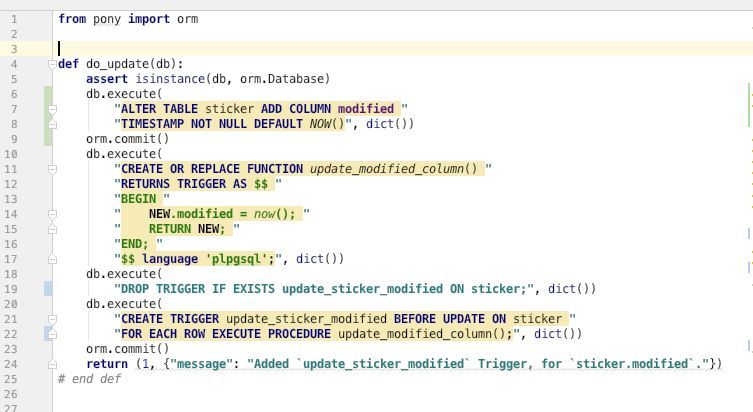does the community edition works well either?
Yes
 Lucky
Lucky
TypeError: 'unique' option cannot be set for PrimaryKey attribute
Shouldn't Primary Keys be unique?
 Anonymous
Anonymous
I would need to use two different databases inside my PONY setup? Both are running on the same mysql server. What's the best way to do so? Currently I only use one database.
 Alexander
Alexander
If those database are mostly independent, you can create two different files with model definitions, and use two different Database objects. Pony allows to work with two different databases in the same db_session.
If you always use these two databases together, another options is to have a single file with model definitions with a single db object. In that case you need to specify table name for each entity and many-to-many relation whose database differ from the database specified in db.bind(...) options:
class MyEntity1(db.Object):
_table_ = ['database1', 'table1']
name = Required(str)
class MyEntity2(db.Object):
_table_ = ['database2', 'table2']
foo = Required(int)
class MyEntity3(db.Object):
# the table placed inside the default database
bar = Required(int)
In MySQL terms, database is a synonym to schema, and you can work with two different schemata placed on the same server thgrough a single connection
 Alexander
Alexander
Hello! Is it possible to use postgres int arrays? I try to implement similarity search
Right now Pony does not support PostgreSQL arrays, we plan support it in the future. You can try to write raw_sql query fragment
 Anonymous
Anonymous
Are there some docs how to "create" these files because at the moment all my models are inside my "main" py file
 Anonymous
Anonymous
For example the attribute "created_at" -> current timestamp, this would save a lot of work when creating new instances inside dbase
 Alexander
Alexander
Just make a separate file, for example models.py with database object and entity definitions:
from pony import orm
db = orm.Database()
class MyEntity(db.Entity):
name = orm.Required(str)
And then in you main file you can do
from models import db
db.bind('mysql', ...)
db.generate_mapping(create_tables=True)
The same with another database
 Alexander
Alexander
For example the attribute "created_at" -> current timestamp, this would save a lot of work when creating new instances inside dbase
import datetime
class MyEntity(db.Entity):
created_at = Required(datetime.datetime, default=datetime.datetime.now)
 Lucky
Lucky
Right now it is better to use JSON if possible
Does using json has any drawbacks on the postgres side?
 Alexander
Alexander
In general, I think no. Some PostgreSQL functions may work with native arrays only, like % operator that @nougmanoff want to use
 Anonymous
Anonymous
@akozlovsky after setting up all my models inside this external files I've only included "from models_server import db" inside my "main" file. Now how to access the class called: "GameServer" I've created inside the models_server?
 Alexander
Alexander
You can access it as an attribute of db object: db.GameServer
Or you can import it from models_server in a usual way
 Anonymous
Anonymous
:) in case you need some servers for PonyORM just drop me a line, that good support...I would need to do something for my karma
 Anonymous
Anonymous
All I found was: http://stackoverflow.com/questions/35851104/how-to-initialize-datetime-0000-00-00-000000-in-python
 stsouko
stsouko
ok. Anybody know how to create transparent converter on postgres side from/to json <> int array?
 Alexander
Alexander
According to this stackoverflow answer
https://dba.stackexchange.com/questions/54283/how-to-turn-json-array-into-postgres-array/54289#54289
You can make PostgreSQL function
 Alexander
Alexander
CREATE OR REPLACE FUNCTION jsonb_arr2text_arr(_js jsonb)
RETURNS text[] AS
$func$
SELECT ARRAY(SELECT jsonb_array_elements_text(_js))
$func$
LANGUAGE sql IMMUTABLE;
 Alexander
Alexander
select(x for x in MyObject if raw_sql("""
jsonb_arr2text_arr(x.json_field -> 'items') % {1, 2, 3}
""")
 Alexander
Alexander
This function returns array of text elements, you need int elements instead, maybe you can change function to return array of ints
 stsouko
stsouko
CREATE OR REPLACE FUNCTION jsonb_arr2int_arr(_js jsonb)
RETURNS int2[] AS
$func$
SELECT ARRAY(SELECT jsonb_array_elements_text(_js)::INT2)
$func$
LANGUAGE sql IMMUTABLE;
 stsouko
stsouko
from pony.orm import *
db = Database()
sql_debug(True)
class A(db.Entity):
_table_ = ('tst', 'a')
a = Required(Json)
db.bind('postgres', user='postgres', password='xxx', host='localhost', database=None)
db.generate_mapping(create_tables=True)
my test DB.
select(x for x in A if raw_sql("json_int2(ta.a) % '{10,9,8,7,6,5,4,3,2,1}'::INT2[]")).limit(50)
my query.
GET NEW CONNECTION
SWITCH TO AUTOCOMMIT MODE
SELECT "x"."id", "x"."a"
FROM "tst"."a" "x"
WHERE json_int2(ta.a) % '{10,9,8,7,6,5,4,3,2,1}'::INT2[]
LIMIT 50
debug sql.
but I get error:
ValueError: unsupported format character 0x20 at index 66
 stsouko
stsouko
10 [122, 39, 85, 109, 112, 104, 7, 60, 192, 162, 64, 148, 79, 111, 165, 97, 176, 175, 135, 131, 26, 58, 36, 167, 22, 62, 74, 45, 130, 194, 129, 199, 120, 119, 14, 168, 190, 142, 68, 159, 4, 16, 169, 43, 50, 125, 134, 178, 132, 93, 34, 140, 10, 121, 173, 57, 28, 6, 96, 123, 44, 83, 133, 70, 127, 66, 54, 77, 114, 161, 105, 124, 78, 67, 158, 113, 146, 116, 32, 185, 128, 117, 11, 196, 160, 153, 188, 1, 195, 118, 81, 92, 95, 75, 94, 30, 73, 3, 29, 18]
example of row in db
 Lucky
Lucky
Wouldl it be better to store images in db or filesystem
Yeah, also you can backup them better.
Think of the huge export.sql file.
 Lucky
Lucky
How would I unload a database?
I am trying to realize the following steps,
basically changing out the database schema, after I ran migrations, which should lead to the new schema file
Example:
from model.v0 import db
db.bind("postgres", host=POSTGRES_HOST, user=POSTGRES_USER, password=POSTGRES_PASSWORD, database=POSTGRES_DB)
db.generate_mapping(create_tables=True)
from migrations.v0 import do_migrate
do_migrate(db)
del db
from model.v1 import db
# repeat the steps with v1
 Alexander
Alexander
I thought you had plan to copy data from one database to another. If it is still true, than you need to create a new database, write a script which copies data from one database to another, and then, after you check that new database is correct, you can just drop previous database manually
 Lucky
Lucky
Currently I want to write a small migrations system myself, so I don't have to do migtations in phppgadmin anymore.
 Lucky
Lucky
 Lucky
Lucky
So the idea is to have this file which will do the migrations, and a file with the database definitions (Entity s) before, to be able to use pony orm syntax (not only raw SQL) in them.
After it modified the table, I'd need to replace the db, loading a file with newer definitions.
 Alexander
Alexander
Ok, I think it is not necessary to unload the previous db object, if you run migration as a script which run separate from your main application
 Lucky
Lucky
It would run as the main app, on startup, and the migration module should return the latest database object.
But you are right, in that case I have to make sure I don't start multible instances at the same time.
 Lucky
Lucky
I don't really have a deploy phase, as I am running it in docker containers.
So everything is done "on startup".


 Micaiah
Micaiah
